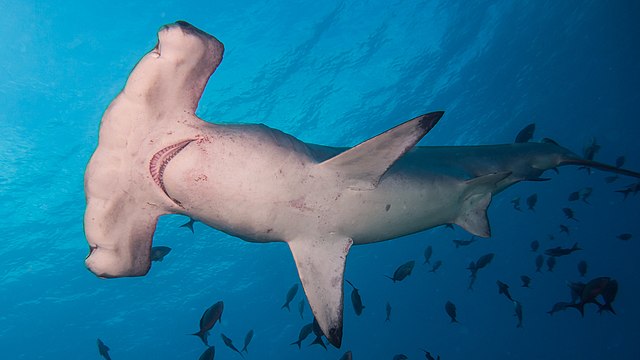
Why are hammerhead sharks shaped like that? The location of their eyes on the end of the hammer give them a greater ability to locate and catch stingrays.
There are several different types of hammerhead shark, but they all have the same hammer-shaped head. This hammer shape is called a cephalofoil. The hammerhead shark with the largest hammer is so big that it is called a winghead shark. Small hammerhead sharks are about a meter long, but the largest ones are up to 6 meters long and weigh 600 kg. They live all over the world in warm waters, in relatively shallow water. Their body is the same shape as other sharks, but they obviously differ in the shape of their head. Their head extends on either side of their body in a flat protuberance and they have an eye on each end. The hammer, in fact all of the shark, is made of cartilage because sharks don’t have bones. Cartilage is much lighter and more flexible than bone.
So, why are hammerhead sharks shaped like that? There appear to be four main reasons. The first is vision. Because of the placement of the shark’s eyes at the end of each “hammer”, they have a 360-degree field of view. They can look completely up and completely down because there is no part of the shark’s body above or below them. By turning their head left and right they can see in front and behind themselves as well. That being said, they do have a blind spot directly above and directly below their heads. Fish have been observed escaping the hammerheads by hiding in this blind spot.
The position of the sharks’ eyes also gives them excellent depth vision. Their eyes are far apart, but they are angled slightly forwards. Our eyes are at the front of our heads and we perceive depth by comparing the image from the left eye and the right eye. The eyes of a hammerhead shark are much further apart than any other shark, which gives them more of an overlap in their vision than any other type of shark. They can use this overlap (48 degrees of overlap for the wingshark) to judge distances accurately. This means they can chase their prey, stingrays, much more effectively.
The second reason is that the shape of their heads allows the sharks to turn more quickly. The hammerheads have to chase fish and stingray, which can turn very quickly, In order to be able to keep up, they have to turn as quickly and their head could give them lift and turning power. This idea doesn’t hold up so well when videos of hammerheads turning are viewed because it seems more likely that their flexible spines help them turn more than their heads.
The third reason is to pin down stingray. When they catch stingray they can stun them and pin them to the floor with their hammerhead, before they eat them. They swim close to the bottom of the sea, where the stingray hide, and their mouths point downwards to make it easier to grab the stingray.
The fourth reason is also to do with finding prey. Sharks have pores in their heads called ampullae of Lorenzini. These are sense organs that can detect electric fields. Every living animal gives off an electric field and sharks can detect it, letting them home in on prey. Hammerhead sharks have many more of these pores than a regular shark, which means they can detect electric fields more easily. This comes in useful because the stingray they like hide under the sand, but their electric field gives them away. Hammerhead sharks can also survey a much larger stretch of sea when looking for prey.
Hammerhead sharks are on the endangered animals list. They have very few natural predators, but humans have fished them almost to extinction. Their fins are prized as a delicacy in some countries and they are quite often “finned”. That is the practice of catching a shark, cutting off the fins, and then throwing the still alive shark back into the sea to suffocate or be eaten by other sharks. It is more profitable for the fishing boats because the fins are small and easy to transport. The practice is illegal, yet it is estimated that it happens to 100 million sharks a year. And this is what I learned today.
Sources
https://en.wikipedia.org/wiki/Hammerhead_shark
https://en.wikipedia.org/wiki/Shark_finning
https://kids.nationalgeographic.com/animals/fish/facts/hammerhead-shark
https://theconversation.com/why-do-hammerhead-sharks-have-hammer-shaped-heads-184372
https://www.newscientist.com/article/dn18210-why-the-hammerhead-shark-got-its-hammer/
https://www.treehugger.com/why-hammerhead-sharks-have-such-funny-heads-4864027
http://news.bbc.co.uk/earth/hi/earth_news/newsid_8376000/8376740.stm
https://www.allthingsnature.org/what-is-a-hammerhead-shark.htm
